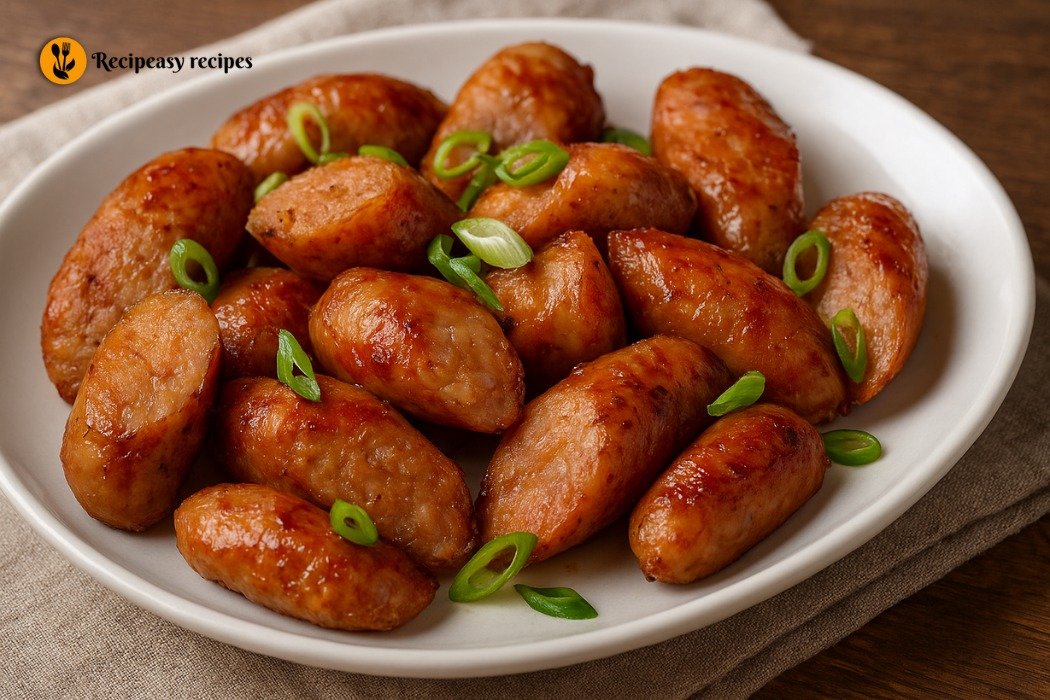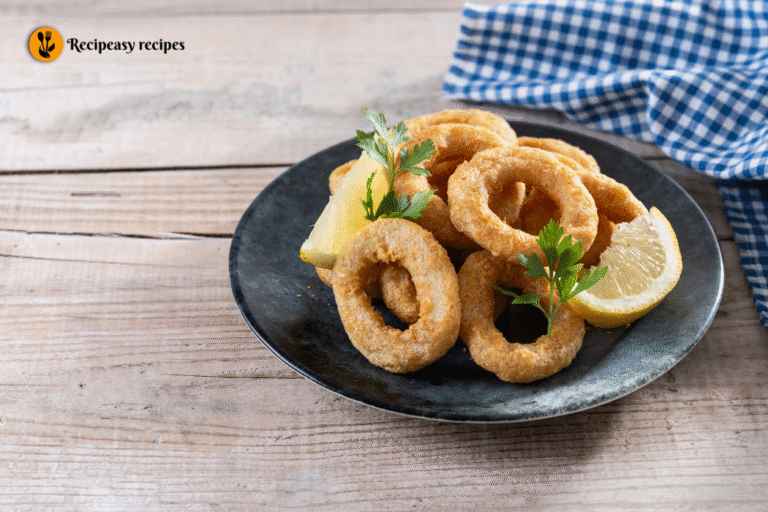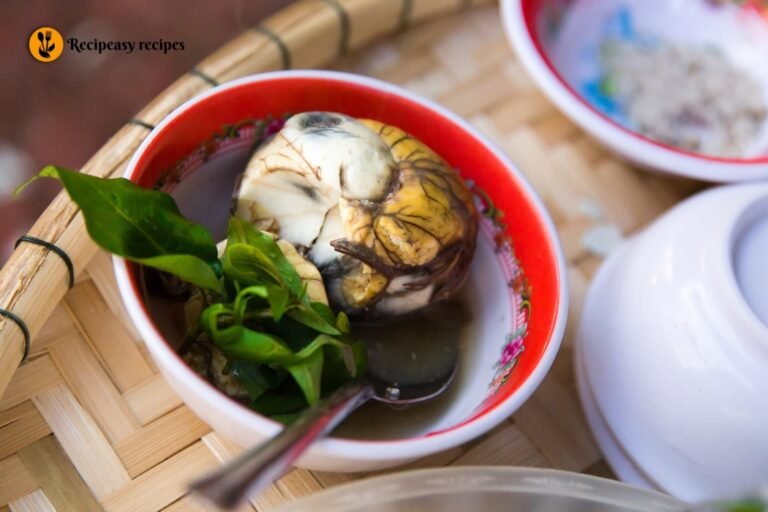Asian Sausage Recipe – Easy Homemade Juicy & Flavorful
I’m a person who loves to try a variety of recipes, and one day I planned to make an Asian Sausage Recipe at home. While sausages are found throughout the world, Asian sausages are unique. Achieving the balance of powerful flavors salty soy sauce, sweet sugar or honey, spicy chili, and fragrant sesame oil or ginger is more important than just eating meat. When I made them for the first time at home, the scent told me it was going to be amazing. Unlike store-bought sausages that sometimes taste plain, Asian sausages carry more flavor.
Each Asian sausages have flavor unlike the boring ones found in supermarkets. Your taste buds will be impressed by the blend of flavors in each bite. The thing that amazed me the most was how easy it is to make them if you know the right steps. You don’t need any special equipment, and if you want it basic, you don’t even need casings. You may make your own sausages that combine traditional and innovative flavors with just minced pork and a few other ingredients. Let’s explore it:
What is Asian sausage made of?
People frequently ask, “What do you put in Asian sausage? Before we start. The answer varies by location, but the basic ingredient is always ground beef, usually chicken or pork, seasoned with sugar, soy sauce, ginger, garlic, and occasionally fish sauce or rice wine. What really sets Asian sausages apart are the spices. They can be hot and pungent, like Thai or Filipino longganisa, or sweet and syrupy, like Chinese lap cheong. The idea behind all of them, regardless of style, is to take simple meat and turn it into something flavorful and rich.
Best Way to Prepare Asian Sausage
I discovered that making Asian sausage at home requires patience and slow preparation when I followed a recipe for the first time. Asian sausages focus on flavor balance as opposed to Western sausages, which frequently contain lots of fat. The first step in any preparation is to thoroughly combine the meat and spices. Every part of the sausage should taste the same. The meat needs to rest for at least an hour, if not overnight, after combining. This is an important step because it enables the spices to blend into the meat and enhance its flavor.
If you omit this step, the flavor of your sausage will be reduced. Cooking is also very important. Although sausages can be grilled, fried, or steam-cooked, I discovered that medium heat yields the most tender results. The interior stays moist while its outer layer turns golden brown. Finding the perfect Asian sausage recipe is as simple as taking your time, letting the flavors marinate, and cooking with love. That’s how you make sausages that are memorable in addition to being delicious.
Asian Sausage Ingredients
When I gathered the Asian sausage ingredients for the first time, I realized that they are things most kitchens already have. The list may look long, but everything works together. Here’s what I used:
· Ground pork (2 pounds, but chicken or beef also works)
· Garlic cloves, finely minced
· Fresh ginger, grated
· Soy sauce for that salty umami base
· Fish sauce (a small amount, for depth)
· Brown sugar or honey for sweetness
· Red chili flakes or fresh chili for heat
· Sesame oil for fragrance
· Rice wine or rice vinegar for balance
· Salt and black pepper to taste
Optional: chopped green onions, cilantro, or lemongrass for freshness
These ingredients are flexible. If you prefer a sweeter taste, add more sugar. If you love spice, add more chili. That’s the fun part of making sausages at home, you can shape them to your taste.
How to Make Asian Sausage Recipe at Home
This process is very interesting for me because I know how it turns out. This recipe have very simple steps and everyone can easily follow. Let’s start:
Step 01: Mixing the Meat and Spices
I began by filling a big bowl with ground meat. I then added each ingredient separately, including the rice wine, sugar, chili, sesame oil, fish sauce, garlic, ginger, and soy sauce. I rubbed them all together in my hands until the meat was sticky and the seasonings were evenly distributed.
Already, the scent was delicious. The soy sauce added depth, the ginger and garlic added a sharpness, and the sugar brought everything together. I put the bowl in the refrigerator for two hours after wrapping it with plastic wrap. This process transforms ordinary ground meat into delicious sausage filling, so it’s worth the wait.
Step 02: Shaping the Sausages
Forming came in second. I reduced it and rolled little portions into thick logs to create skinless sausages. They were easier to prepare because they looked like homemade, rustic sausages without casings.
You can place them in natural shells if you want to be more conventional, but that requires other tools. I imagined how good they would taste cooked when I placed them on a tray. The mixture was sticky and sufficiently firm to hold its shape.
Step 03: Cooking the Sausages
Cooking was the most exciting part. I tried three different methods, and each gave a slightly different taste and texture. I’m going to explore all methods of Cooking the sausages but you can choose anyone that feels convenient for you. Let’s go:
Method 01: Pan-Frying: I melted some oil in the pan and carefully inserted the sausages. The smell of garlic, soy, and sesame oil soon filled the kitchen as sizzling filled the air. To ensure they browned evenly, I cooked them over medium heat, rotating them every few minutes.
The result was delicious sausages that were golden-brown on the inside. Although the outside was a little crispy, the flavor was well-balanced and improved. This method is simple and perfect for everyday cooking.
Method 02: Grilling: I used a barbecue to cook the sausages for my second batch. The charred taste that the grill’s smoky warmth added went well with the marinade’s sweet and savory flavors. It reminded me of street food in many Asian countries.
Where sausages are sold hot to hungry crowds after being roasted on sticks. They tasted much better after grilling, and in my opinion, it’s the greatest way to wow your visitors at a BBQ.
Method 03: Steaming and Frying: Before frying, several Asian recipes include steaming the sausages. I have also done this. After about fifteen minutes of steaming, I pan-fried the sausages lightly. The finished product was incredibly soft sausages with a lovely golden brown exterior and a juicy interior. Although it takes a little more effort, this method keeps sausages juicy and cooks them evenly.
Step 04: Serve the Dish
The cooked sausages were golden and delicious when I placed them on a dish. Layers of flavor were there in every bite, including the warmth of ginger and garlic, the spiciness of chili, the saltiness of soy sauce, and the sweetness of sugar. Every swallow was an experience.
The sausages were excellent with noodles, stir-fried vegetables, and even steaming rice. Every bite has more flavor than just meat. I realized then why Asian sausages are so well-liked in so many countries. Now, add presentation to the dish and serve it at the table to enjoy.
a). Spicy Asian Sausage Recipe
It’s easy to turn this into spicy Asian sausage if you want strong flavors. Every chili preparation that I tried provided a unique twist. Thai bird’s eye spicy cut up for a sharp spice, redder chili flakes for steady heat, or even chili paste for a smoky, powerful burn.
I once tried adding Korean gochujang, which is spicy fermented chili paste, to the mixture, and the result was hot, sweet, and tangy sausages, a fun twist that will never be forgotten. So don’t hold back if you enjoy spicy. Asian sausages love heat, and you’ll find your own unique flavor balance the more you experiment.
b). Regional Variations of Asian Sausages
One of the things I love most about making Asian sausages is how many variations exist across different countries. Each region adds its own culture and taste to the recipe.
1 Chinese Lap Cheong:This sausage is usually made with pork and has a strong, sweet flavor. It’s dried, slightly chewy, and often steamed with rice. It’s one of the most famous Asian sausages.
2 Thai Sai Ua: From northern Thailand, this sausage uses pork mixed with lemongrass, kaffir lime leaves, galangal, and chili paste. It’s very aromatic and spicy.
3 Filipino Longganisa: These sausages are garlicky and slightly sweet. They can be either fresh or cured, and they are often eaten with garlic fried rice and eggs for breakfast.
4 Korean Soondae: Because it uses noodles and vegetables that have been mixed with blood and meat and placed inside a casing, this version is very different. It’s a popular street snack. Every one of these variations encouraged me to experiment with various ingredients and helped me realize how diverse and interesting the world of Asian sausages is.
Serving Ideas
Asian sausages are versatile and can be served in many ways. Here are some of my favorite pairings:
· With plain steamed rice for a simple meal.
· With stir-fried noodles for a comforting dish.
· Wrapped in lettuce leaves with herbs for a fresh bite.
· Sliced and added to fried rice.
· Add it in the dish with vegetables for a party snack.
No matter how you serve them, they add a burst of flavor to the plate.
Storage Tips
There are a lot of people who must be concerned about storing the sauce in the fridge. It’s actually easy to store the sausages in the fridge for up to two days. If you can’t cook, you can have it for later cooking. The technique I use, I wrap them tightly and freeze the sausages for extended storage. When the sausages are frozen, you can keep them for up to 3 months.
Simply take the frozen sausages from the fridge, thaw and cook them as same as the recipe whenever you want to eat. The sausages have a great flavor, even after being frozen, you will have each bite will be delicious. I typically save leftovers in the refrigerator and reheat them the next morning. I can surely say that they still test great.
Tips for Beginners
I learnt from my experience that if you are making the sausages from home for the first time. Then you need to consider some special tips that will help you in your cooking journey. To ensure that each bite has the same flavor then mix the meat and spices very well. Before cooking, just let the mixture rest for at least 35 to 40 minutes. Overnight is the best option if you can. This is the most important step for having a deep flavor in each bite.
Avoid overcooking and choose medium heat to keep the sausages juicy on the inside. Your medium flame will work better instead of high. Don’t worry if you don’t want to use casings, skinless sausages are equally delicious and flavorful. At the final tip, I want to tell you that don’t be afraid to try new things. Asian flavors give us plenty of freedom to try a variety of spices and herbs. So you can have the best-tasting sausages in your home. Do try it and be fearless.
Why You Should Try Asian Sausage Recipe
The most satisfying eating experience is probably making your own Asian sausage recipe. It allows you to customize to your preferences while also keeping you in touch with classic flavors. It’s not as hard as it looks, and the rewards are far greater than anything you could buy at the shop.

Making these sausages in my own home kitchen was a global experience for me. Every meal was worth the effort, and the joy of sharing them with someone you cared about enhanced the experience.
Conclusion
Making an Asian sausage dish at home is such a rewarding experience. It’s something you’ll remember, from mixing the meat with flavorful spices, shaping it with your own hands, frying or baking it in different ways, and finally enjoying the deep, rich taste. This guide gives you all the information you need, whether you want to know what ingredients go into making Asian sausage or you’re trying to find the ideal recipe.
Simple ingredients for Asian sausages allow you to create delicious sausages that suit your tastes, including a spicy Asian sausage recipe if that’s your thing. Try making your own Asian sausages the next time you’re craving something new and daring. They’re tasty, simple, and a terrific way to share.
FAQs
What is Asian sausage made of?
Ground beef, pork, or chicken is typically combined with sugar, chili powder, sesame oil, ginger, garlic, and soy sauce to make Asian sausages.
What is the best Asian sausage recipe?
The ideal recipe creates a balance between savory, spicy, salty, and sweet ingredients. A genuine taste is produced by combining garlic, ginger, soy sauce, sesame oil, and sugar adding chili enhances the flavor.
Can I make a homemade Asian sausage recipe without casings?
Yes, you can shape the mixture into skinless sausages or patties. They cook just as well and are easier for beginners. Casings are traditional but not necessary.
What are the main Asian sausage ingredients?
Ground meat, garlic, ginger, soy sauce, sesame oil, sugar, and chili are the main ingredients. Optional items include rice wine, fish sauce, and herbs like lemongrass or cilantro.
How do I make a spicy Asian sausage recipe?
To make it spicy, add extra chili flakes, fresh chili, or chili paste. You can also experiment with spicy sauces like gochujang for a deeper heat.
How should I cook Asian sausages?
They can be pan-fried, grilled, steamed, or baked. Each method gives a slightly different texture and flavor. Pan-frying is easiest, while grilling adds a smoky taste.
Asian Sausage Recipe – Easy Homemade Juicy & Flavorful
Course: SnacksCuisine: AsianDifficulty: Easy4–5
servings20
minutes25
minutes250 kcal per serving
kcalThis Asian Sausage Recipe is sweet, savory, and juicy with soy sauce, garlic, and ginger. Easy to make at home perfect for grilling or pan-frying.
Ingredients
. Ground pork (2 pounds, but chicken or beef also works)
· Garlic cloves, finely minced
· Fresh ginger, grated
· Soy sauce for that salty umami base
· Fish sauce (a small amount, for depth)
· Brown sugar or honey for sweetness
· Red chili flakes or fresh chili for heat
· Sesame oil for fragrance
· Rice wine or rice vinegar for balance
· Salt and black pepper to taste
Optional: chopped green onions, cilantro, or lemongrass for freshness
How to Make Asian Sausage Recipe at Home
- Step 01: Mixing the Meat and Spices
I began by filling a big bowl with ground meat. I then added each ingredient separately, including the rice wine, sugar, chili, sesame oil, fish sauce, garlic, ginger, and soy sauce. I rubbed them all together in my hands until the meat was sticky and the seasonings were evenly distributed.
Already, the scent was delicious. The soy sauce added depth, the ginger and garlic added a sharpness, and the sugar brought everything together. I put the bowl in the refrigerator for two hours after wrapping it with plastic wrap. This process transforms ordinary ground meat into delicious sausage filling, so it’s worth the wait. - Step 02: Shaping the Sausages
Forming came in second. I reduced it and rolled little portions into thick logs to create skinless sausages. They were easier to prepare because they looked like homemade, rustic sausages without casings.
You can place them in natural shells if you want to be more conventional, but that requires other tools. I imagined how good they would taste cooked when I placed them on a tray. The mixture was sticky and sufficiently firm to hold its shape. - Step 03: Cooking the Sausages
Cooking was the most exciting part. I tried three different methods, and each gave a slightly different taste and texture. I’m going to explore all methods of Cooking the sausages but you can choose anyone that feels convenient for you. Let’s go:
Method 01: Pan-Frying: I melted some oil in the pan and carefully inserted the sausages. The smell of garlic, soy, and sesame oil soon filled the kitchen as sizzling filled the air. To ensure they browned evenly, I cooked them over medium heat, rotating them every few minutes.
The result was delicious sausages that were golden-brown on the inside. Although the outside was a little crispy, the flavor was well-balanced and improved. This method is simple and perfect for everyday cooking.
Method 02: Grilling: I used a barbecue to cook the sausages for my second batch. The charred taste that the grill’s smoky warmth added went well with the marinade’s sweet and savory flavors. It reminded me of street food in many Asian countries.
Where sausages are sold hot to hungry crowds after being roasted on sticks. They tasted much better after grilling, and in my opinion, it’s the greatest way to wow your visitors at a BBQ.
Method 03: Steaming and Frying: Before frying, several Asian recipes include steaming the sausages. I have also done this. After about fifteen minutes of steaming, I pan-fried the sausages lightly. The finished product was incredibly soft sausages with a lovely golden brown exterior and a juicy interior. Although it takes a little more effort, this method keeps sausages juicy and cooks them evenly. - Step 04: Serve the Dish
The cooked sausages were golden and delicious when I placed them on a dish. Layers of flavor were there in every bite, including the warmth of ginger and garlic, the spiciness of chili, the saltiness of soy sauce, and the sweetness of sugar. Every swallow was an experience.
The sausages were excellent with noodles, stir-fried vegetables, and even steaming rice. Every bite has more flavor than just meat. I realized then why Asian sausages are so well-liked in so many countries. Now, add presentation to the dish and serve it at the table to enjoy.
a). Spicy Asian Sausage Recipe
It’s easy to turn this into spicy Asian sausage if you want strong flavors. Every chili preparation that I tried provided a unique twist. Thai bird’s eye spicy cut up for a sharp spice, redder chili flakes for steady heat, or even chili paste for a smoky, powerful burn.
I once tried adding Korean gochujang, which is spicy fermented chili paste, to the mixture, and the result was hot, sweet, and tangy sausages, a fun twist that will never be forgotten. So don’t hold back if you enjoy spicy. Asian sausages love heat, and you’ll find your own unique flavor balance the more you experiment.
b). Regional Variations of Asian Sausages
One of the things I love most about making Asian sausages is how many variations exist across different countries. Each region adds its own culture and taste to the recipe.
1 Chinese Lap Cheong:This sausage is usually made with pork and has a strong, sweet flavor. It’s dried, slightly chewy, and often steamed with rice. It’s one of the most famous Asian sausages.
2 Thai Sai Ua: From northern Thailand, this sausage uses pork mixed with lemongrass, kaffir lime leaves, galangal, and chili paste. It’s very aromatic and spicy.
3 Filipino Longganisa: These sausages are garlicky and slightly sweet. They can be either fresh or cured, and they are often eaten with garlic fried rice and eggs for breakfast.
4 Korean Soondae: Because it uses noodles and vegetables that have been mixed with blood and meat and placed inside a casing, this version is very different. It’s a popular street snack. Every one of these variations encouraged me to experiment with various ingredients and helped me realize how diverse and interesting the world of Asian sausages is.
Notes
- Resting the meat mixture for at least 1–2 hours (or overnight) helps the spices soak in for a richer flavor.
- For juicier sausages, always cook on medium heat high heat can dry them out.
- You can make skinless sausages if you don’t have casings; they’re just as tasty and easier for beginners.







